There are just two important criteria when choosing a smoothie blender:
1. A smoothie blender should give you the maximum health benefits from each serving.
2. It should have a proven high success rate in allowing people to make smoothies every day.
Below are our two recommended best blenders for smoothies, along with our detailed "must-have" blender ratings methodology.
*all sources and data included at end of article
The Winners
#1 Top Pick: Vitamix 5200
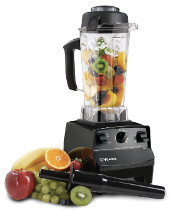
Our Top Pick for "Best Smoothie Blender" is the The Vitamix 5200. This is our personal smoothie blender of choice and is the best overall value on the market.
Because this blender handles frozen and whole uncut fruits with the use of Vitamix's patented tamper device, you don't have to mess around and waste any time. In fact, we guarantee that if you are making smoothies every day, this blender will pay for itself in 3 months.
WHERE TO BUY: You can save up to half off from their certified refurbished inventory, which are the same as new.
#2 Runner Up: Blendtec Total Blender
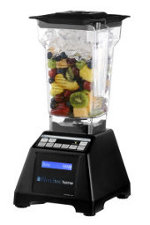 The Blendtec Total Blender is also a great smoothie maker. It has a 1500 Watt motor, a futuristic electronic display, no knobs or dials, and includes a 96-ounce jar along with a book of over 100 recipes.
The Blendtec Total Blender is also a great smoothie maker. It has a 1500 Watt motor, a futuristic electronic display, no knobs or dials, and includes a 96-ounce jar along with a book of over 100 recipes.One special feature of this blender is its automatic pre-programmed "smoothie" cycle, which means you can start it up and it will turn off automatically when blending is finished. It will also auto-adjust if it needs more power to finish.
All new Blendtec blenders come with their patented "Wildside container" which adds an additional fifth side, helping to prevent the formation of air pockets. This eliminates the need for repeated stopping and starting while blending.
WHERE TO BUY: You can save up to $150 off any Blendtec by using this Blendtec Promo Code savings guide. Using that code also assures you the lowest price and a bonus recipe book.
Our Rating Methodology
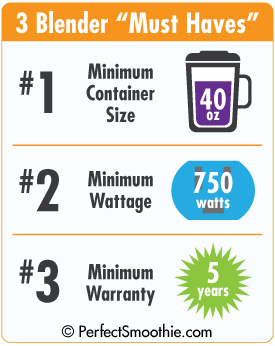
We don't recommend the most expensive blenders, just the ones that work the best based on our experience making smoothies daily for over 15 years, using every type of ingredient and preparation method possible.
Our team has created 3 "must haves" any blender needs if it allows you to get the maximum health benefits while making smoothies every day.
3 "Must Have" Smoothie Blender Requirements
If your goal is to make smoothies daily to significantly improve your health (and believe us will it ever), then these are the absolute must have things to look for.
Must Have #1 - Minimum 40 fl. oz. Container
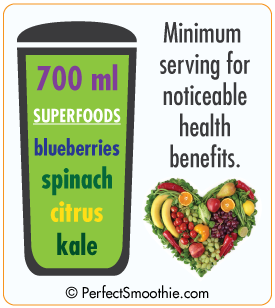 Even with nutrient-dense super foods like spinach, kale, and blueberries, you'll need to moderately pack a 40 fl. oz. (1.18 Liter) blender container to yield a 700 ml smoothie serving.
Even with nutrient-dense super foods like spinach, kale, and blueberries, you'll need to moderately pack a 40 fl. oz. (1.18 Liter) blender container to yield a 700 ml smoothie serving.
This serving size yields a portion that has at least 100% of the daily recommended amounts of Vitamins A and C, as well as significant quantities of other important health promoting micro-nutrients and phytochemicals.
Based on our experience, and those of our readers, this is the appropriate minimum daily serving size to notice significant health benefits from a smoothie.
If your blender container is smaller than 40 fl. oz. you'll have to either go through the entire blending process twice, or repeatedly blend, stop, repack, blend, etc. We've found that having to do this will over time prevent people from making smoothies regularly as it is too much work. *details of micro-nutrient calculation included at end of the article
Must Have #2 - Minimum 750 Watts
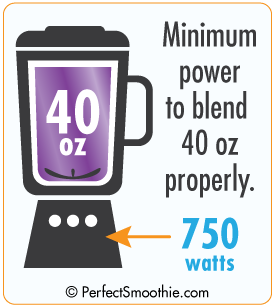 Any blender with less than 750 Watts of power won't have enough power to blend a full 1.18 liter (40 fl. oz.) container.
Any blender with less than 750 Watts of power won't have enough power to blend a full 1.18 liter (40 fl. oz.) container.
This is the absolute minimum amount of power you'll need to get the ingredients blended (and circulating properly) in a reasonable amount of time.
Additionally, this is also the necessary amount of power to effectively blend both ice cubes as well as small nuts such as almonds so that the consistency will be completely smooth without leftover chunks.
Must Have #3 - Minimum 5 Year Warranty
A blender should offer no less than a 5 year warranty. Why 5 years? Based on our research any blender with a warranty under 5 years has an overwhelmingly high chance of breaking down if used daily to make smoothies.
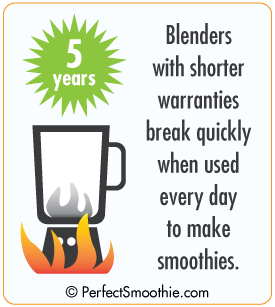 If you read the Amazon.com reviews for their best sellers and filter out only the reviews where people used the blenders to make smoothies daily and they did this over a long period, overwhelmingly, most look like this:
If you read the Amazon.com reviews for their best sellers and filter out only the reviews where people used the blenders to make smoothies daily and they did this over a long period, overwhelmingly, most look like this:
"We loved [the Ninja Professional Blender] until it stopped working, May 8, 2014 - By John Chirlin (Albany, NY USA) - ... We loved it until it failed this morning. We ordered it in early April and used it every morning to make our smoothies. Nothing crazy, just frozen fruit, yogurt and some other equally easy to blend items. It blended everything really well. This morning it simply stopped working...."
For blenders being used every day to make smoothies this happens way too often. Therefore, we STRONGLY recommend not buying from a manufacturer that warranties their blender for just one year, (such as Ninja, Nutri-Bullet, and KitchenAid), and even 3 years (such as Cuisinart or Hamilton Beach) as when used daily they aren't reliable.
Alternative High-End Blenders
What other 3 blenders met our "must have" requirements for being one of the best blenders for smoothies?
The Next Generations of Vitamix & Blendtec
Both Vitamix and Blendtec have "next generations" of blenders that have been on the market for less than 2 years. These are not our top recommendations because they are more expensive due to having extra features that aren't necessary for successfully making smoothies every day.
However, if you have no limit to your budget and want the absolute newest technology these are worth considering:
Vitamix 7500
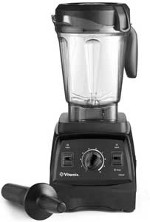 Vitamix 7500 / Vitamix Professional Series 300: Vitamix's next generation boasts two main improvements over the previous 5200 model. The entire unit now is 17.5" tall and has a stouter container enabling it to fit under most standard counter tops. Additionally, the motor base has been redesigned to provide the same power output with 40% less noise emission.
Vitamix 7500 / Vitamix Professional Series 300: Vitamix's next generation boasts two main improvements over the previous 5200 model. The entire unit now is 17.5" tall and has a stouter container enabling it to fit under most standard counter tops. Additionally, the motor base has been redesigned to provide the same power output with 40% less noise emission.Note: the 7500 and Professional Series 300 are the exact same blender. The only difference is that the latter costs $30 more and comes with a full-color hardbound "Create" cookbook with recipes from gourmet chefs and a tutorial DVD by Chef Micael Voltaggio.
Blendtec Designer Series Wildside
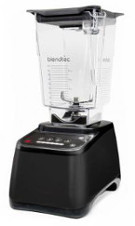 The Blendtec Designer Series boasts Blendtec's newest generation of technology. This includes a "direct-drive" motor shaft technology, which gives the blender a 3-peak horsepower, as well as a new air-flow system which keeps the motor cooler during operation. Because of this, Blendtec now offers an 8 year warranty standard for this blender, as opposed to the previous 7 year standard.
The Blendtec Designer Series boasts Blendtec's newest generation of technology. This includes a "direct-drive" motor shaft technology, which gives the blender a 3-peak horsepower, as well as a new air-flow system which keeps the motor cooler during operation. Because of this, Blendtec now offers an 8 year warranty standard for this blender, as opposed to the previous 7 year standard. This blender also includes pre-programmed cycles for smoothies, ice cream, whole juice, and hot soup. The noise rating for this is the same as the previous Total Blender design, so if the new look and programmable options are appealing to you that would be the reason to choose this blender.
Vitamix Professional Series 750
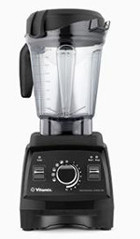 What blender would you buy if money was no object, and you wanted the best blender ever made? The Vitamix 750 would be your answer. In addition to the new generation of improvements included in the 7500 model, the Vitamix 750 boasts five pre-programmed settings for smoothies, hot soups, frozen desserts, purées, and auto-cleaning.
What blender would you buy if money was no object, and you wanted the best blender ever made? The Vitamix 750 would be your answer. In addition to the new generation of improvements included in the 7500 model, the Vitamix 750 boasts five pre-programmed settings for smoothies, hot soups, frozen desserts, purées, and auto-cleaning.One of the reasons this blender is branded as "professional" is that the programmed settings are ideal for making large quantities and hands-free multi-tasking in the kitchen. If you don't mind paying an extra $200 dollars for this functionality, then you won't be disappointed with this blender.
Lower Priced Blenders
If you are new to smoothie making it may be more cost-effective to first try something less expensive to decide whether making smoothies regularly is right for you.There are, however, several important caveats to be aware of when purchasing a lower priced blender, and the manufacturers themselves will never tell you this:
- Not designed for daily use: Cheaper priced blenders are not designed to be used every day. Their warranties are typically limited to 1 year or less, and if used daily they usually last less than a year.
- Blending takes longer: Because these blenders have lower-powered motors, the blend cycles will always take significantly longer. You are also not guaranteed to always get a perfectly smooth consistency.
- Extra Preparation Time: The reason we strongly prefer the Vitamix 5200 is that its patented tamper device allows you to virtually skip pre-cutting any ingredients. These lower-priced blenders require additional preparation time in that you have to cut up the fruit and vegetables into reasonably small-sized pieces for them to blend properly.
- Limited to mostly fresh ingredients: With a lower priced blender, you will be limited to mostly fresh non-frozen ingredients. The lower priced motors aren't strong enough to blend a jar full of frozen contents. The downside is that fresh ingredients cost significantly more than frozen, and you'll have to shop more frequently.
- Extra cleaning steps: The last thing to be aware of is that none of the lower priced blenders come with the same sealed-blade assembly containers like the Vitamix or Blendtec. This means that after each use (per the manufacturers instructions) you'll have to disassemble the blade base and wash each component separately. This adds a significant amount of time to making smoothies and is why most people who make smoothies every day always end up getting a high-end blender.
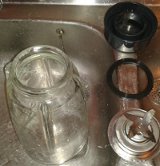
Our Suggestion
Because none of the lower priced blenders meet our "must-have" criteria, we don't recommend using them to make smoothies every day. However, if you are wanting to try whether making smoothies is for you, then a cheaper way to go could be to buy a lower-priced blender.
Breville Hemisphere Control Blender
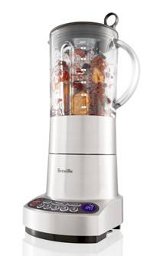 The Breville BBL605XL Hemisphere Control Blender stands out among our best blenders for smoothies in the lower price category. Because Vitamix has a patent on their tamper device, this has forced other manufacturers to find creative ways to improve the blending process using alternative engineering methods. The result is Breville's patented hemisphere blade system. This unique design forces larger ingredients towards the bottom of the cup-shaped container. This blender has an elegant stainless steel body, an easy to use lcd timer for pre-programmed smoothie blending cycles, a 750 Watt motor, and a 6-cup co-polyester container that is dishwasher safe.
The Breville BBL605XL Hemisphere Control Blender stands out among our best blenders for smoothies in the lower price category. Because Vitamix has a patent on their tamper device, this has forced other manufacturers to find creative ways to improve the blending process using alternative engineering methods. The result is Breville's patented hemisphere blade system. This unique design forces larger ingredients towards the bottom of the cup-shaped container. This blender has an elegant stainless steel body, an easy to use lcd timer for pre-programmed smoothie blending cycles, a 750 Watt motor, and a 6-cup co-polyester container that is dishwasher safe.
WHERE TO BUY: The Breville Hemisphere Blender is available with free shipping from Amazon.
Oster Beehive
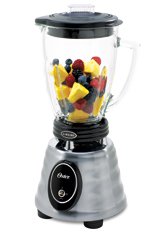 The Oster Beehive is a classic looking stainless steel 500 Watt smoothie blender that can blend most non frozen items and looks like a piece of art on your kitchen counter with its retro beehive design. It has a simple knob control with 2 speeds. The jar is made out of glass and is relatively easy to keep clean. We used this smoothie machine exclusively for about a year before upgrading to the Vitamix 5200 in order to blend frozen items and whole fruits to save time and money.
The Oster Beehive is a classic looking stainless steel 500 Watt smoothie blender that can blend most non frozen items and looks like a piece of art on your kitchen counter with its retro beehive design. It has a simple knob control with 2 speeds. The jar is made out of glass and is relatively easy to keep clean. We used this smoothie machine exclusively for about a year before upgrading to the Vitamix 5200 in order to blend frozen items and whole fruits to save time and money.
WHERE TO BUY: The Oster Beehive is also available with free shipping from Amazon.
If you do decide you want to stick with making smoothies every day, then a great way to save money is to send your lower-priced blender back within the return policy window and upgrade to either a certified refurbished Vitamix or Blendtec. These aren't considerably more and will save you lots of time and money in the long run.
Insights into our Review Methodology
Minimum Container Size Calculation
Based on our research the smoothie yield of a "moderately" packed container is approximately 75%, assuming you're adding 1 cup of liquid to the container.
Here is an illustration of three container sizes and the amount they would yield in this scenario:
32 fl. oz. X .75 = 24 fl. oz. = 709 ml -> After the smoothie is poured, there will be less than 700ml actually consumed.
40 fl. oz. X .75 = 30 fl. oz. = 880 ml -> Just right to fill a standard 828 ml (28 fl. oz) sized Blender Bottle.
64 fl. oz. X .75 = 48 fl. oz. = 1419 ml -> This yields slightly less than two 700 ml servings, after the servings are poured. (but still a useful container size for making two servings)
Visual Demonstration
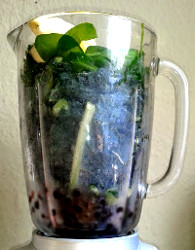
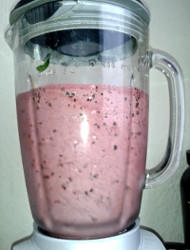
The first image shows a 2 Liter blender container filled to approximately 1600 ml and moderately packed with 1 cup of water added. After 60 seconds of blending, we see that the yield is approximately 1200 ml. The ratio in this case would be 1600 ml (initial ingredients) / 1200 ml (volume after blending) = .75 yield, thus demonstrating the usefulness of this ratio as a good yield guideline.
The reason we have 40 fl. oz. as the minimum cut-off value for a blender container is that a 32 fl. oz. container yields almost exactly our recommended minimum portion size. However, the yield must be slightly greater than this to account for the portion of the smoothie that will stick to the inside of both the container after being poured, and to the inside of the drinking container being used.
Thus, if the goal is to actually consume 700 ml worth of the smoothie the 40 fl. oz. container is the absolute minimum size required. The standard size for smoothie drinking containers like the popular Blender Bottles are 28 fl. oz. / 828 ml (filled to the rim). If you want to use these to drink your smoothies (which we recommend), then a 40 fl. oz. container size would create the perfect yield.
Also note, 40 fl. oz. is the absolute minimum size container to yield just one optimal health-promoting serving. If you plan to make more than one serving a fully packed 64 fl. oz. container will yield roughly two 700 ml portions. This is the standard container size for both Vitamix and Blendtec, and we think this is a good sized container to have in case you ever make more than one portion at a time.
Minimum Serving for Optimal Nutrition
The ingredients we used in our above photos were as follows (we used a food scale for exact measurements):
- 3/4 cup (125 grams) frozen blueberries
- 40 grams frozen spinach
- 40 grams frozen kale (or just double the spinach)
- 1 small lemon (73 grams)
- 1 regular sized banana (88 grams)
- 4 Brazil nuts (14 grams)
- 1 small handful of almonds (20 grams)
- 1 cup hot water
- 1 scoop chocolate Gold Standard protein powder (32 grams)
This recipe should yield a volume of 800 ml (or 27 fluid ounces), about the exact size of a standard 28 fl. oz. Blender Bottle container. The nutritional content is shown below.
You'll see that even after using the most nutrient-dense foods available such as kale, spinach, and blueberries, we've still just barely gone over the 100% daily recommended amounts of Vitamins A & C. The almonds and brazil nuts in the recipe also contain rich amounts of Vitamin E not shown below. This is why we suggest a minimum serving size of 700 ml using these nutrient dense foods, as this puts you reliably just over the 100% RDA value.
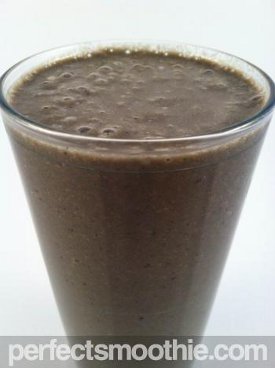
| Nutrition Facts | ||||||
|
Serving Size
1 serving (532.0 g) |
||||||
Amount Per Serving |
||||||
|
Calories 377 Calories from Fat 128 |
||||||
% Daily Value* |
||||||
|
Total Fat
14.2g 22%
|
||||||
|
Saturated Fat
2.4g 12%
|
||||||
|
Trans Fat
0.0g |
||||||
|
Cholesterol
21mg 7%
|
||||||
|
Sodium
131mg 5%
|
||||||
|
Potassium
1012mg 29%
|
||||||
|
Total Carbohydrates
57.2g 19%
|
||||||
|
Dietary Fiber
10.9g 44%
|
||||||
|
Sugars
27.8g |
||||||
|
Protein
24.9g |
||||||
|
||||||
* Based on a 2000 calorie diet
|
How We Chose Our 5 Best Smoothie Blenders
The 5 blenders we recommend are a result of applying our 3 "must-have" smoothie-making criteria to the top 50 blenders of all four of the following organization's review and sales data: Good Housekeeping, Amazon, Consumer Reports, and CNET.
These organizations put a lot of effort into their testing and in several cases provide very useful insights. We'd like to thank them for providing these resources. For reference, the complete list of data we compiled can be found by clicking the image below: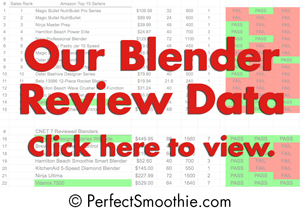
It is important to note that the focus of their testing was not on which blenders most effectively allowed a consumer to make smoothies daily, over the long term, and for the maximum health benefit. Thus, we created our extra layer of "must-have" requirements to filter through their ratings.
Final Thoughts & Feedback
You'll never know how much time and money purchasing a high-end blender will save until you test one. Whatever blender you decide to buy, the "best blender for smoothies" for you is going to be the one that makes smoothie making easy enough such that you use it every day.
Tip: If you're looking for the best blender to make things other than smoothies we recommend checking out BestBlender.com.
Thank you so much for reading our review. Our goal is to provide the most thorough point of research and data collection for the best smoothie blenders. If you have any suggestions for updates or corrections, please don't hesitate to contact us.
